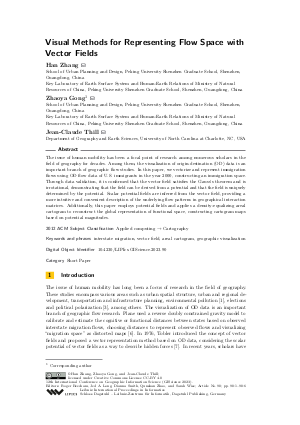Visual Methods for Representing Flow Space with Vector Fields (Short Paper)
Authors Han Zhang, Zhaoya Gong, Jean-Claude Thill
-
Part of:
Volume:
12th International Conference on Geographic Information Science (GIScience 2023)
Part of: Series: Leibniz International Proceedings in Informatics (LIPIcs)
Part of: Conference: International Conference on Geographic Information Science (GIScience) - License:
 Creative Commons Attribution 4.0 International license
Creative Commons Attribution 4.0 International license
- Publication Date: 2023-09-07
File

PDF
LIPIcs.GIScience.2023.90.pdf
- Filesize: 3.03 MB
- 6 pages
Document Identifiers
Subject Classification
ACM Subject Classification
- Applied computing → Cartography
Keywords
- interstate migration
- vector field
- areal cartogram
- geographic visualization
Metrics
- Access Statistics
-
Total Accesses (updated on a weekly basis)
0PDF Downloads0Metadata Views
Abstract
The issue of human mobility has been a focal point of research among numerous scholars in the field of geography for decades. Among them, the visualization of origin-destination (OD) data is an important branch of geographic flow studies. In this paper, we vectorize and represent immigration flows using OD flow data of U.S. immigrants in the year 2000, constructing an immigration space. Through data validation, it is confirmed that the vector field satisfies the Gauss’s theorem and is irrotational, demonstrating that the field can be derived from a potential and that the field is uniquely determined by the potential. Scalar potential fields are inferred from the vector field, providing a more intuitive and convenient description of the underlying flow patterns in geographical interaction matrices. Additionally, this paper employs potential fields and applies a density-equalizing areal cartogram to reconstruct the global representation of functional space, constructing cartogram maps based on potential magnitudes.
Cite As Get BibTex
Han Zhang, Zhaoya Gong, and Jean-Claude Thill. Visual Methods for Representing Flow Space with Vector Fields (Short Paper). In 12th International Conference on Geographic Information Science (GIScience 2023). Leibniz International Proceedings in Informatics (LIPIcs), Volume 277, pp. 90:1-90:6, Schloss Dagstuhl – Leibniz-Zentrum für Informatik (2023)
https://doi.org/10.4230/LIPIcs.GIScience.2023.90
BibTex
@InProceedings{zhang_et_al:LIPIcs.GIScience.2023.90,
author = {Zhang, Han and Gong, Zhaoya and Thill, Jean-Claude},
title = {{Visual Methods for Representing Flow Space with Vector Fields}},
booktitle = {12th International Conference on Geographic Information Science (GIScience 2023)},
pages = {90:1--90:6},
series = {Leibniz International Proceedings in Informatics (LIPIcs)},
ISBN = {978-3-95977-288-4},
ISSN = {1868-8969},
year = {2023},
volume = {277},
editor = {Beecham, Roger and Long, Jed A. and Smith, Dianna and Zhao, Qunshan and Wise, Sarah},
publisher = {Schloss Dagstuhl -- Leibniz-Zentrum f{\"u}r Informatik},
address = {Dagstuhl, Germany},
URL = {https://drops.dagstuhl.de/entities/document/10.4230/LIPIcs.GIScience.2023.90},
URN = {urn:nbn:de:0030-drops-189852},
doi = {10.4230/LIPIcs.GIScience.2023.90},
annote = {Keywords: interstate migration, vector field, areal cartogram, geographic visualization}
}
Author Details
- School of Urban Planning and Design, Peking University Shenzhen Graduate School, Shenzhen, Guangdong, China
- Key Laboratory of Earth Surface System and Human-Earth Relations of Ministry of Natural Resources of China, Peking University Shenzhen Graduate School, Shenzhen, Guangdong, China
- School of Urban Planning and Design, Peking University Shenzhen Graduate School, Shenzhen, Guangdong, China
- Key Laboratory of Earth Surface System and Human-Earth Relations of Ministry of Natural Resources of China, Peking University Shenzhen Graduate School, Shenzhen, Guangdong, China
References
-
Michael Batty. The new science of cities. MIT press, 2013.

-
Zhaoya Gong and Jean-Claude Thill. Vector field based approach to reconstruct and represent functional spaces with areal cartogram, 2017.

-
Xi Liu, Clio Andris, and Bruce A Desmarais. Migration and political polarization in the us: An analysis of the county-level migration network. PloS one, 14(11):e0225405, 2019.

-
Mattia Mazzoli, Alex Molas, Aleix Bassolas, Maxime Lenormand, Pere Colet, and José J Ramasco. Field theory for recurrent mobility. Nature communications, 10(1):3895, 2019.

-
Peter Nijkamp and Waldemar Ratajczak. Gravitational analysis in regional science and spatial economics: A vector gradient approach to trade. International Regional Science Review, 44(3-4):400-431, 2021.

-
David A Plane. Migration space: Doubly constrained gravity model mapping of relative interstate separation. Annals of the Association of American Geographers, 74(2):244-256, 1984.

-
Waldo Tobler. Spatial interaction patterns, 1975.

-
Jingyuan Wang, Jiahao Ji, Zhe Jiang, and Leilei Sun. Traffic flow prediction based on spatiotemporal potential energy fields. IEEE Transactions on Knowledge and Data Engineering, 2022.

-
Hu Yang, Minglun Li, Bao Guo, Fan Zhang, and Pu Wang. A vector field approach for identifying anomalous human mobility. IET Intelligent Transport Systems, 17(4):649-666, 2023.

